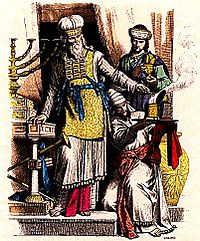

LA JOLLA, California — This parasha deals mainly with God’s instructions for the elaborate vestments-outfitting of Aaron, the first High Priest, and his four sons. This is followed by instructions for their ordination.
My search of the internet for analogous written passages for High Priests in the pagan world yielded no such gods’ instruction. However, I did find descriptions of pagan priests’ garments.
Mesopotamia– Priests and Priestesses were equals to the king in power and honor. They were mediators between the gods and the people. Their expressions to the gods included feeding and clothing their statues, and composing and singing songs to them. Young candidates for such priesthood had to be perfect in body, come from a good family, and demonstrate talent as a scribe. [1]
Clothing was of woven linen for both the priests and the statues of the gods. Other finely woven fabrics also ultimately became available. Soft cotton was introduced in Assyria around 700 BC, and silk became available later. [2]
Egypt– Only the priest was allowed to enter the sacred area of the temple and approach the statue of the god(s). The priest’s role was to care for the needs of the god/goddess. Care consisted of: In the morning the high priest breaks the seal to the sacred area, lights a torch to walk the god, says prayers, lights incense, washes the statue (which may be solid gold), places fresh clothing and jewels on it and places offerings of food and drink near it. At the end of the day, the priest backs out of the shrine, sweeping away his footprints as he goes, and seals the sacred area again.
New priests were often chosen by the Pharaoh, and often they chose relatives. Many positions were hereditary.
Priests were only allowed to wear linens or clothing made from plant sources. Articles of clothing made from animals were not permitted. They were required to shave their heads and bodies daily. They had to practice sexual abstinence when on duty. [3]
Rome– There were multiple categories of priests, and these changed over time. Ultimately the Pontifex Maximus became the chief priest, which became the Pope when the empire became Christian. [4]
*
Irv Jacobs is a retired medical doctor who enjoys writing about a variety of interests, including both religion and science. He may be contacted via irv.jacobs@sdjewishworld.com
